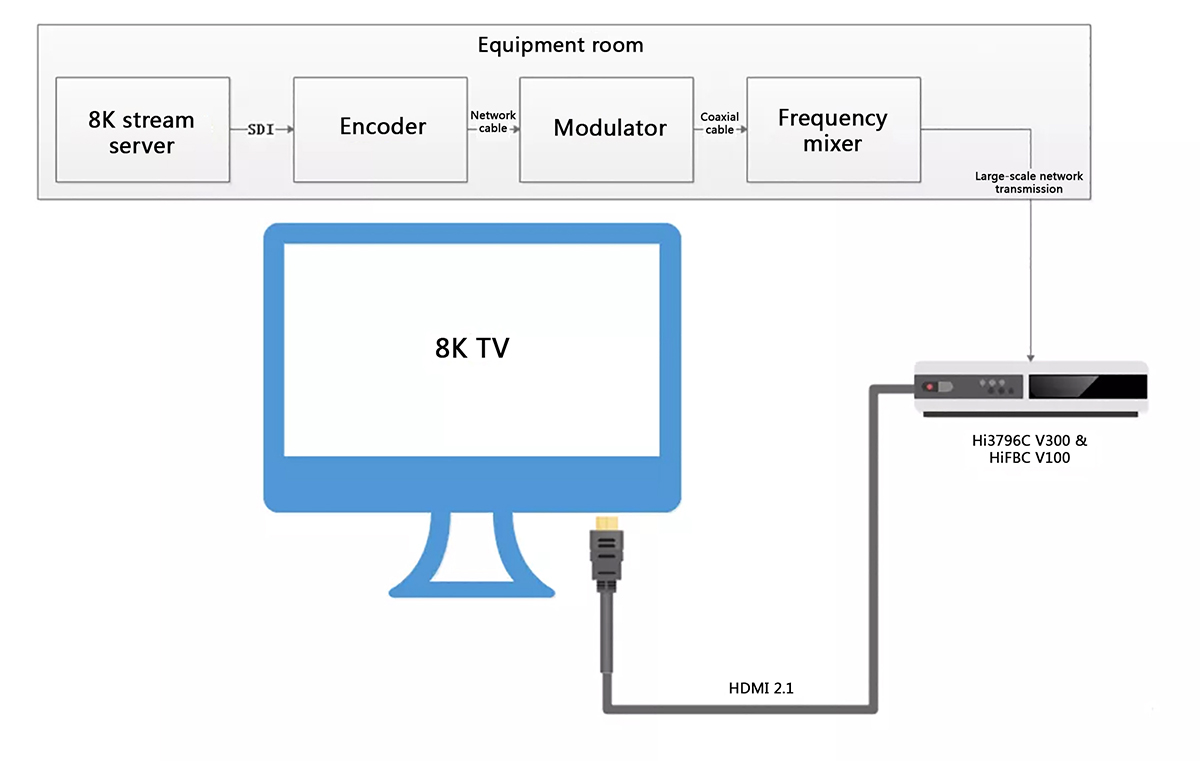Back
- Applications
- Products
- Support
- About HiSilicon
No Result


Industry Insiders Were Pessimistic About CBN's 8K Live Broadcasting
Primary reasons:
1. 8K programs require high bit rates. The bandwidth of a single encoded 8K program ranges from 80 Mbit/s to 140 Mbit/s. The cable network used by the China Broadcasting Network (CBN) consists of separate frequency bands, with each occupying a bandwidth of 8 MHz. The valid data transmission bandwidth is 38 Mbit/s for the 64-QAM format and 50 Mbit/s for the 256-QAM format, far below the peak of 1400 Mbit/s and even below the lower limit of 80 Mbit/s.
2. Modulation above 256-QAM requires high hybrid fiber coax (HFC) network quality. In China, there are no commercial networks which have this.

HiSilicon 8K Makes the Decisive Difference
HiSilicon (Shanghai) teamed up with industry partners to propose a high-bandwidth transmission solution that binds multiple frequencies within a single HFC network for JSCN (Suzhou). After a theoretical demonstration, R&D, lab testing, and live network testing, this solution was able to achieve the end-to-end transmission of 8K live TV channels on the HFC network. The tests proved the technical feasibility of transmitting 8K channels on an HFC network, which enhances 8K live broadcasting over cable networks.

The solution consists of encoding on headends, HFC network modulation and transmission, and signal decoding and receiving on devices.
The headend uses the most advanced AVS3 8K encoder in China. The AVS3 encoding and decoding standard comprehensively improves the basic structure of block division, inter-/intra-frame encoding tools, and filters, with the compression ratio 30% higher than that of H.265. AVS3 supports 8Kp60 and 8Kp120 real-time encoding, so it meets the requirements of ultra-HD videos at a low bit rate and bolsters the development of 8K technology. HiSilicon is leading the implementation and industrialization of end-to-end, full 8K/4K products and solutions based on the AVS standard system, such as chipsets and STBs which feature AVS ultra-HD decoding. HiSilicon has participated in the formulation of the AVS3 standard, and is actively supporting partners in debugging and testing the standard.
In terms of modulation and HFC transmission, a combination of three frequencies was used. This ensured a minimum bandwidth of 80 Mbit/s and a peak bandwidth of 140 Mbit/s to support 8Kp120 transmission. JSCN (Suzhou) released two sets of frequencies for the tests. One set consisted of three consecutive frequencies: 650/658/666 MHz, and the other consisted of three non-consecutive frequencies: 211/411/514 MHz. For all frequencies, a modulation format of 256-QAM was used to ensure a maximum transmission bandwidth of 150 Mbit/s.
For the device, a full-band tuner was used to receive HFC signals of multiple frequencies at the same time. The decoder received the three frequencies specified by the headend simultaneously, restored the streams according to the timing, program specific information (PSI), and service information (SI), and then sent them to the decoder. The decoder was embedded with HiSilicon's latest 8K decoding chipset, the most powerful 8K decoding chipset in China. It features decoding of up to 8Kp120, an octa-core high-performance CPU, and a 12-core GPU.

Test Scenarios
Scenario 1: 650/658/666 MHz
Test result: The transmission was good when the bit rate ranged from 80–100 Mbit/s. The bit error rate (BER) increased as the bit rate rises to between 110 and 140 Mbit/s.
Scenario 2: 211/411/514 MHz
Test result: In lab and equipment room environments, the transmission was good at 100 Mbit/s. On a large-scale network, bit errors occurred continuously at 211 MHz, occasionally at 411 MHz, and rarely at 514 MHz. On a large-scale network, the noise floor at 211 MHz was 20 dB higher than that at nearby frequencies. At 409.5 MHz, the noise floor fluctuated occasionally.
In conclusion, you are advised to use consecutive frequencies for 8K live TV transmissions in subsequent cable network deployment. Based on these test results, the proposal of the cable network 8K end-to-end transmission standard was submitted to the National Radio and Television Administration. The standard should be published in the near future.

This site uses cookies. By continuing to browse the site you are agreeing to our use of cookies. Read our privacy policy